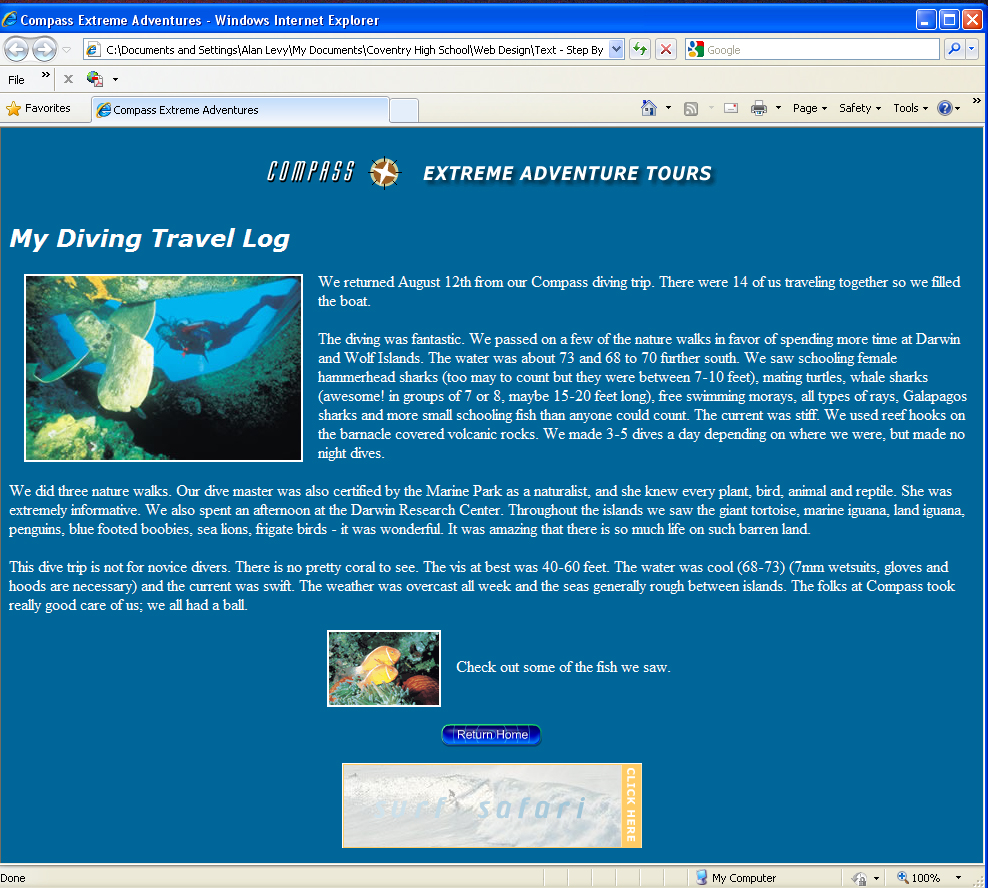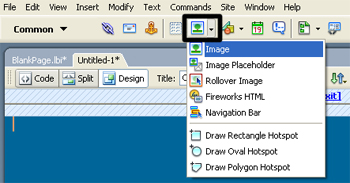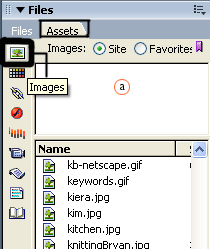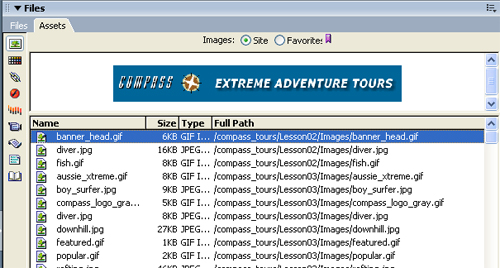For this lesson, you will create a simple web page like the one shown in the illustration below: In the process of creating the page, you will learn many different ways to format text and customize the look of your page.

Click picture to view full-size image
Before you begin this lesson, you must be able to identify the graphics formats commonly used on web pages. Click here to learn the difference between, and when it is appropriate to use gif or jpg files.
Placing Graphics on the Page
Dreamweaver lets you choose how it references images: with document-relative or siteroot-relative references. With document-relative referencing, Dreamweaver constructs the path to the image based on the relative location of your HTML document to the graphics file. Site-root-relative referencing constructs the path to the image based on the relative location of that image from your site root.
Generally, you should use document-relative links and paths. If you have an extremely large site, or if you plan to move pages frequently within the server, you might want to use site-rootrelative referencing.
Until you save your file, Dreamweaver has no way to create the reference. You should always save your document before you insert graphics. If you don't, Dreamweaver displays an alert box and then fixes the filename path when you do save the Dreamweaver file.
-
Step-by-Step 2.1: Inserting a Graphic by Using the Insert Bar
- Before staring Dreamweaver, create a folder named Images in your compass-tours folder. This will help stay organized.
- Save the following image files into your Images folder:
- banner_head.gif
- diver.jpg
- fish.gif
- Start Dreamweaver.
- Click the File menu and click New. In the New Document dialog box, make sure Basic Page is selected in the Category list and HTML in the Basic Page list, and then click Create.
- Save the document as travel_log, followed by your initials in your compass_tours folder.
- In the document Title box, key Compass Extreme Adventures.
- Click the Modify menu and then click Page Properties.
- In the Page Properties dialog box, make sure Appearance is selected in the Category List. Change the Background color to #006699 and the Text color to #FFFFFF. Then click OK.
- Click in the document to make sure the insertion point is on the first line of the document.
- From the Common category on the Insert bar, click Images and then click Image.

Optional: click the Insert menu and then click Image to insert a graphic on the page. The Select Image Source dialog box opens.
- Locate and open the Images folder, and locate the file banner_head.gif in the Images folder.
- In the Relative To box, make sure Document is selected. The document filename travel log.htm appears to the right of the menu.
- Click OK (Windows) or Choose (Macintosh).
- On the Property inspector, key banner in the image name text box (it's on the far left, under the word Image), as shown in Figure 2-1. Although naming your images is not essential, it is a good practice. Non-text objects in a Web page must have names if you want to include user interactivity enhancements (Lesson 5).

- Save your work and remain in this screen for the next Step-by-Step.
When you import a graphic, the width and height of the graphic are automatically added on the Property inspector. This gives the browser the information it needs to define the layout of the page.
You can use the width and height attributes to create a special effect for a graphic without making the graphic larger or smaller in file size. For example, you can create a 1-pixel by 1-pixel graphic of a color-a solid dot. Use the width attribute to create a colored line across the page; use the height attribute to change its height.
Note: Including the width and height of the image in the HTML code can make a difference in the time it takes for a browser to render your page. You can change these numbers in Dreamweaver, but don't! If you scale the image larger, the image quality diminishes. You could scale the image smaller and it would look OK, but you won't have changed the file size; thus, the graphic will take just as long to download. Always adjust the image size in image-editing software (such as Fireworks) to ensure that you use the smallest file size possible.
Working with Graphics and Adding Adding Alt Text
The Alt attribute (Alt being a shortened form of Alternate) lets you specify text to be displayed on browsers when graphics can't be displayed. This is a significant feature to add to any graphic, particularly graphics that are critical for navigation. If users have disabled graphic display or are using a text-only browser, at least they can see some of the information they are missing. People with vision disabilities use a reader that speaks the Alt tags along with the text on a Web page. In some browsers, Alt text is displayed briefly when the user moves the pointer over the graphic.
-
Step-By-Step 2.2 - Working with Graphics and Adding Alt Text
- Make sure the banner head.gif image is selected.
- On the Property inspector, key Compass Extreme Adventure Tours in the Alt text box.
- On the Property inspector, click the Align Center button, shown in Figure 2-2. If you don't see the Align Center button, click the expander arrow at the bottom right of the Property inspector.

- Click outside the banner graphic to deselect it. Press Enter (Windows) or Return (Macintosh) to move to the line below the banner graphic, and key My Diving Travel Log. Select the text, and click the Italic button, click the arrow on the Format box and select Heading 2, select the Verdana, Arial, Helvetica font, and click the Align Left button.
- Create a new paragraph under the heading and make sure the line is set to Paragraph format and left alignment. Make sure that the Italic button is not selected.
- Next, insert a new image by using the Assets panel. On the Assets panel, click the Images button. (If the Assets panel is not open, click the Window menu, and then click Assets.

- Drag the diver.jpg graphic from the Assets panel to the document and place it below the heading.
- Key Diver in the Alt text box on the Property inspector. Key diver in the image name text box.
- Save the document and remain in this screen for the next Step-by-Step.
Adding Images to Asset Favorites
All images used within a site are listed as site assets on the Assets panel. For images that are used repeatedly, placing them in Image Favorites can be a time-saver. You can organize your images into folders to make them easy to locate.
It might take a few seconds for the panel to create a listing of all the assets used by files in your site. If you haven't created a site cache for this site, the Assets panel prompts you to do so; the asset catalog can't be created without a site cache.
If you add a new asset to your site, it might not immediately appear on the Assets panel. To update the Assets panel to include all the images in your site, you need to refresh the site catalog. Click the Refresh Site List button at the bottom right of the Assets panel. (this button is only available when Site is selected in the Assets panel).
-
Step-By-Step 2.3 - Working with Asset Favorites
- Click Site at the top of the Assets panel. Click the Full Path column heading to rearrange the images according to their folder structure (path), as shown in Figure 2-5 (you may need to resize the panel to see the column). This places all the images in the Lesson02 folder together.

- Select the fish.gif graphic from the list of images.
- Click Add to Favorites at the lower right of the panel. (And click OK if a message box appears.)
- Click Favorites at the top of the Assets panel. The fish.gif image is listed in Favorites.
- Remain in this screen for the next Step-by-Step.
To create a folder in Asset Favorites, click New Favorites Folder at the bottom of the panel. Once you have created a folder, you can collapse it or expand it by double-clicking it.
To remove an image from Asset Favorites, select the image from the list of images and then click Remove from Favorites. The image is no longer listed as a Favorite. You haven't deleted the image-it is still in its original location-you've simply removed it from the list of Favorites. To remove a folder from Asset Favorites, select the folder to delete, and then click Remove from Favorites at the bottom of the panel.
Note: If a Favorites folder you want to remove contains any images you want to keep as Favorites, first move the images to another folder.
Wrapping Text Around Images
A common formatting preference is to have text wrap around a graphic on the page. You can achieve this easily by changing the Align attribute of the image. For text wrapping to work properly, make sure the image is inserted at the beginning of a paragraph. The text wraps to the bottom of the graphic and then returns to the left margin of the window.
Dreamweaver gives you several alignment options for images, including Top and Text Top. If you want your text to wrap or move to the top of the image, you might think that one of these options would work. Remember that multiline text can wrap only on either the left or the right side of an image, so the only options that will accomplish this are Left or Right. If you want to place the image on the left and wrap the text on the right, select the image and choose Left in the Align field. If you want to place the image on the right and wrap the text on the left, select the image and choose Right in the Align field.
The other alignment options on the pop-up menu are for the placement of a single line of text next to a graphic. You will work with these later.
-
Step-By-Step 2.4 - Wrapping Text Around an Image
- Open the file diving.txt
- Select all the text, and click Copy on the Edit menu. Close the diving.txt file without saving.
- In the travel_log.htm file, paste the copied text to the right of the diver graphic. Left-align all the text. You might need to insert paragraph breaks manually.
- Select the diver graphic. On the Property inspector, choose Left from the Align pop-up menu, as shown in the Figure below. The text wraps around the diver graphic.

- Save the file and preview it in your browser.
- Close your browser and remain in this screen for the next Step-by-Step
Modifying the Space and Adding a Border Around Images
When you use an Align option to wrap text around graphics, you'll probably want to adjust the space around the image as well. You can do this on the Property inspector.
-
Step-By-Step 2.5 - Adding Space and a Border Around an Image
- Make sure the Diver graphic is selected.
- On the Property inspector, enter 15 in the H Space text box. This creates 15 pixels of space on both the left and right sides of the image. You cannot add space on only one side.
- Enter 2 in the V Space text box. This creates 2 pixels of space at both the top and bottom of the image.
- In the Border text box of the Property inspector, enter 2. Press Enter (Windows) or Return (Macintosh) to see the change. A 2-pixel border is added to the diver image.
- Save your document and remain in this screen for the next Step-by-Step.
Aligning Images and Text
Often you'll want to control the placement of a graphic on the page in relation to a single line of text that appears near it. You can change the relative location of the graphic to the text by using options on the Property inspector.
-
Step-By-Step 2.6 - Aligning a Single Line of Text Near a Graphic
- Press Enter (Windows) or Return (Macintosh) at the end of the document to add a new line.
- On the Assets Favorites panel, drag the fish.gif image to a new line after the body text. Key Fish in the Alt text box, and key fish in the image name text box.
- On the Property inspector, click the Align Center button. Be sure to click the button; don't select Center on the Align menu.
- Position the insertion point to the right of the Fish graphic and key Check out some of the fish we saw. The text is aligned with the bottom of the graphic and is too close to the graphic.
- Select the Fish graphic and add a 2-pixel border to it.
- On the Property inspector, enter 15 in the H Space text box. This will force the graphic and text to move apart.
- From the Align pop-up menu, choose Middle. The baseline of the text is aligned with the middle of the graphic.
- Save the file and preview it in your browser.
- Close the browser and remain in this screen for the next Step-by-Step.
Image Alignment Options
You need to understand how the alignment options work. The following seven options work well for aligning a single line of text near a graphic. As you saw earlier, they don't work for wrapping multiple lines around a graphic (use Left or Right instead). Here's what happens when you use the Align pop-up menu:
- Baseline: Aligns the bottom of the image with the baseline of the text line.
- Top: Aligns the image with the top of the tallest item in the line.
- Middle: Aligns the baseline of the text line with the middle of the image.
- Bottom: Identical to Baseline.
- Text Top: Does what many people think Top should do, which is to align the image with the top of the tallest text in the line (this is usually, but not always, the same as Top).
- Absolute Middle: Aligns the middle of the text line with the middle of the image.
- Absolute Bottom: Aligns the bottom of the image with the bottom of the text line.
Creating a Home Page
You can easily achieve special effects by using buttons and animations created in Flash. Because Flash graphics are vector-based, they have very small file sizes. This helps them load quickly in the user's browser.
-
Step-by-Step 2.7: Creating a Home Page
- Select File --> New ---> Blank Page
- Save As default.htm
Note: We will replace this page later, but you need a home page to link to for the next step.
Adding Flash Objects
You can easily achieve special effects by using buttons and animations created in Flash. Because Flash graphics are vector-based, they have very small file sizes. This helps them load quickly in the user's browser.
Adding Flash Buttons
Flash buttons have several different states, depending on the position of the pointer and whether the mouse button has been clicked. The first state is the look of the button when the pointer is not on it. The second state appears when the pointer is on the button but the mouse has not been clicked. The third state appears when the pointer is on the button and the mouse has been clicked. You can create and maintain Flash buttons in Dreamweaver from a set of available button styles. Many of the button attributes are changeable. In the following Step-by-Step, you create a button and then modify it.
-
Step-by-Step 2.8: Creating and Modifying a Flash Button
- Open Dreamweaver and Open your travel-log.htm page.
- Move to the end of the text and Press Enter (Windows) or Return (Macintosh) to position the insertion point below the Fish graphic and the text in the center of the Document window.
- From the Common category of the Insert bar, click the small arrow to the right of the Media button, and then click Flash Button. The Insert Flash Button dialog box opens.
- Make the following changes:
- From the Style pop-up menu, choose Blue Warper.
- In the Button Text text box, key Return Home.
- From the Font pop-up menu, choose Verdana (or your font choice if Verdana is not available).
- In the Size text box, enter 12.
- Click the Browse button next to the Link text box and navigate to the default.htm page you made for the compass_tours folder
- For Bg Color, click the color picker. Then use the eyedropper to click anywhere on the background in the Document window. The background color code #006699 appears in the Bg Color text box.
- In the Save As text box, key home_button.swf and then click OK. The Insert Flash Button dialog box closes and the button you created appears in the document.
- With the Flash button still selected, click Play on the Property inspector. The button is in its original state.
- In the Document window, move the pointer over the Return Home button. The button changes to its rollover state.
- Click the button. It changes to its clicked state.
- Click Stop on the Property inspector.
- Save the file and preview it in your browser. The button changes states just as it did in Dreamweaver, depending on the pointer position and mouse click.
- Close your browser.
Next, you modify the Flash button.
- In the Document window, double-click the button. The Insert Flash Button dialog box opens.
- Make some changes to the options. For example, change the font to Arial.
- Click Apply to see the changes.
- Click OK when you finish.
- Save your work and remain in this screen for the next Step-by-Step.
Adding Flash Animations
You can add Flash animations to your document as easily as adding an image, provided the animation has already been created. You can resize the animations to your specification by dragging the handles. Unlike Flash buttons, you cannot create these animations directly within Dreamweaver.
-
Step-By-Step 2.9 - Adding a Flash Animation
- Create a new folder called Flash and save surfAd.swf there.
- Open your travel-log.htm file in Dreamweaver (if it is not already open).
- Press Enter (Windows) or Return (Macintosh) to position the insertion point below the Flash button on your page. If your insertion point is not centered, click Align Center on the Property inspector. The insertion point is now centered on the page. The next object you add to the page will be centered.
Note: Always be sure to select a SWF file when inserting a Flash animation. Do not insert FLA or SWT files because they will not show up in a browser
- On the Assets panel, click Flash. You may have to adjust the column widths to see the Nicknames column.
- From the Assets panel, select the surfAd.swf file and click the Insert button on the bottom-left corner of the Assets panel. The Flash animation is placed on the page.
- On the Property inspector, make sure Loop and Autoplay are selected. Autoplay causes the Flash animation to begin playing as soon as the page is loaded in the browser. The animation plays repeatedly because the Loop property is set in Dreamweaver. Click Play to view the animation in Dreamweaver.
- Click Stop on the Property inspector.
- Save the file and preview it in your browser.
- When you are finished, close your browser, close the travel-log.htm file, and then close Dreamweaver.
Congratulations! This completes Assignment 2: Creating a Compass Tours Web Page

